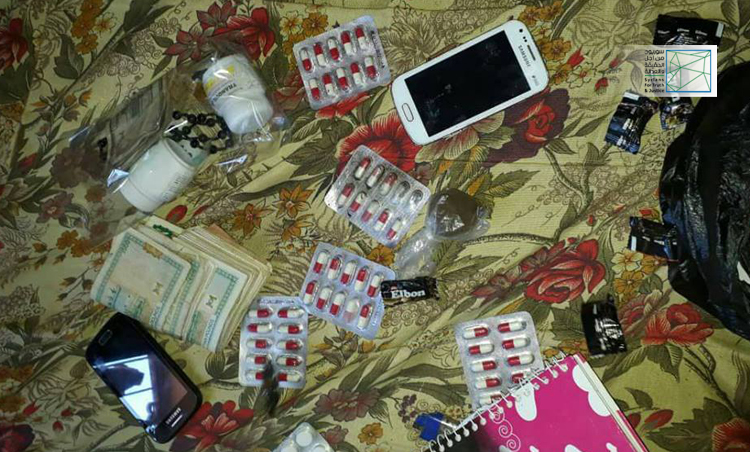In northern rural Homs, the phenomenon of drug and narcotic pills abuse has been witnessing an apparent growth, extensively proliferating among children and adolescents, particularly 15 and 16 years old. Drug abuse and promotion spread widely under the Syrian regular forces’ control of the area, in comparison to its spread during the reign of the armed opposition groups and anti-Syrian government factions, for several eyewitnesses, who Syrians for Truth and Justice/STJ interviewed, confirmed the involvement of a few elements and officers of the regular forces and the Lebanese Hezbollah in the promotion and distribution of drugs, especially volunteers and fresh recruits.
Between the 10th and 18th of November, 2018, STJ’s field researcher in northern rural Homs met several eyewitnesses, both drug abusers and relatives, who all refused to reveal their identities for security considerations. They addressed the extensive promotion and trafficking of drugs under the control of the armed opposition groups and then under the reign of the regular forces.
Under the pseudonym Ghassan, a drug user, informed STJ’s field researcher about the spread of the phenomenon:
“Since 2013 and during the control of the armed opposition groups, there was a person, called (Karmo.H), who smuggled hashish, narcotic pills, counterfeit currency and antiquities from and to the regime’s areas. His car easily got in and out of northern Homs. (Karmo’s) work prospered and he started to transport his commodities between Homs and Qalamun, after which he was prosecuted by the Free Court in the Northern Countryside. He, then, escaped from the area and volunteered in the Military Security Service, joining another dealer called Khairo. Today, he and Khairo work together in the distribution of drugs in the regions of al-Rastan and al-Sleibeh. In the region of Talbiseh, however, the principal distributor is (Abdulsalam.B), whose work expands to the eastern region, al-Makramia and al-Zaafraneh. He works under the cover of the Military Security Service and has strong ties with the forces in control of the al-Qusayr. Another dealer and promoter, called (Ramah.R), buys his commodities from Homs city, from the neighborhoods of al-Khalidiyah and al-Zahraa. Drugs reach these neighborhoods from Lebanon, through the al-Qusayr, preliminary controlled by Hezbollah’s forces, on top of whom is a commander called (Mohammad.B).”
About becoming involved in narcotic pills abuse, Ghassan said:
“I got introduced to a person called (Khalid.H), who is a volunteer in the Military Security. Khalid arranged a meeting including hashish and narcotic pills, after which I started using them. There is another person, (Mohammad.H), who is considered one of the drugs top promoters in the military security. Today, he is in prison, for two months ago he was caught while possessing certain amounts of hashish.”
Under a pseudonym, Ahmad, a relative to a narcotic pills’ abuser, said that the selling process is often conducted in the majority of the area’s cafes at night. It is easy to find promoters and small vendors, retailers. The target group, however, is children/adolescents, starting from those who are 15 years old, for a massive number of these adolescents are volunteers or recruits under semi-regular forces, affiliated with the regular forces; some of them have also volunteered in security services, especially the Military Security, where they are lured with monthly salaries and free hashish sessions.
Ahmad added that persons from the area’s northern rural parts are generally reputed for being hashish and narcotic materials’ abusers, a habit they started a long time ago, during the control of the factions and before.
According to STJ’s field researcher in northern rural Homs, the price of a Captagon pill and Marijuana (Cannabis) capsule ranges from 600 to 700 Syrian pounds, while it was sold for 300 to 400 SP only during the reign of the opposition armed groups. Additionally, a single gram of hashish is sold for 25,000SP, while it was previously sold for 14,000SP.
The phenomenon of drug abuse has been begrudging throughout Syria, especially at the onset of this year. Covering this issue, STJ published several reports on the proliferation of drugs abuse in the provinces of Raqqa, Idlib and Hama, given the lack of censorship and accountability, as well as the involvement of the controlling authorities in the trade. [1]
[1] “Raqqa- Spread of Phenomenon of Selling and Promoting for Narcotic Pills in the Absence of Serious Steps to Prevent Them”, Syrians for Truth and Justice, August 14, 2018. Last visit: January 30, 2019. https://stj-sy.org/en/view/694.
“Raqqa: The Increasing Use and Sale of Illegal Drugs in al-Tabqah and its Surroundings”, Syrians for Truth and Justice, August 31, 2018, Last visit: January 30, 2019. https://stj-sy.org/en/view/694.

